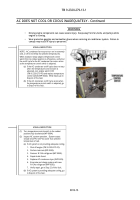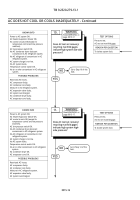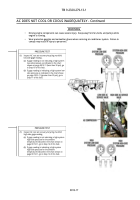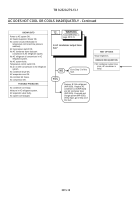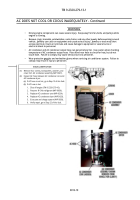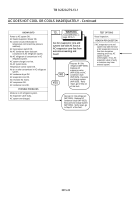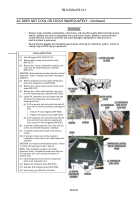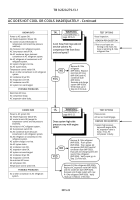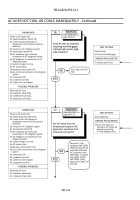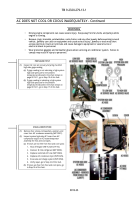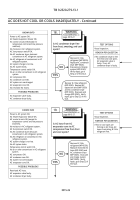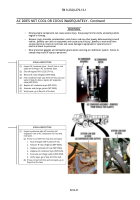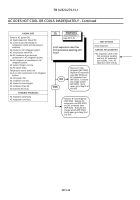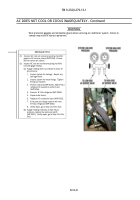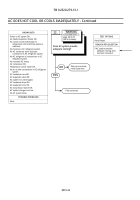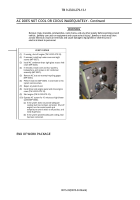TB-9-2320-279-13-1 - Page 192 of 524
TB 9-2320-279-13-1
0015-24
AC DOES NOT COOL OR COOLS INADEQUATELY - Continued
DRAFT
-
-
-
-
-
-
-
-
-
-
-
-
-
-
-
-
-
-
-
-
-
-
-
-
-
-
-
-
-
-
-
-
-
-
-
-
-
-
-
-
-
-
-
-
-
-
-
-
-
-
-
-
-
-
-
-
-
-
-
-
-
-
-
-
-
-
-
-
-
-
-
-
-
-
-
-
-
-
-
-
-
-
-
-
-
-
-
-
-
-
-
-
-
-
-
-
-
-
-
-
-
-
-
-
-
-
-
-
-
-
-
-
-
-
-
-
-
-
-
-
-
-
-
-
-
-
-
-
-
-
-
-
-
-
-
-
-
-
-
-
-
-
-
-
-
-
-
-
-
-
-
-
-
-
-
-
-
-
-
-
-
-
-
-
-
-
-
-
-
-
-
-
-
-
-
-
-
-
-
-
-
-
-
-
-
-
-
-
-
-
-
-
-
-
-
-
-
-
-
-
-
-
-
-
-
-
-
-
-
-
-
-
-
-
-
-
-
-
-
-
-
-
-
-
-
-
-
-
-
-
-
-
-
-
-
-
-
-
-
-
-
-
-
-
-
-
-
-
-
-
-
-
-
-
-
-
-
-
-
-
-
-
-
-
KNOWN INFO
Power to AC system OK.
AC heater/evaporator blower OK.
AC control circuits OK (except for
temperature control and low pressure
switches).
No moisture in AC refrigerant system.
AC low pressure switch OK.
No AC condenser dryer desiccant
contaminant in AC refrigerant system.
No AC refrigerant oil contaminant in AC
refrigerant system.
AC system charge is not low.
No AC system leaks.
Temperature control switch OK.
No air or other contaminant in AC refrigerant
system.
AC compressor OK.
AC condenser core OK.
AC system not overcharged.
POSSIBLE PROBLEMS
Restricted AC hose.
AC expansion valve faulty.
AC condenser dryer faulty.
AC evaporator core faulty.
16.
Does AC test set recovery/
recycling manifold gages
indicate high system high-
side pressure?
Go to Step 19 of this
fault.
NO
YES
Read WARNING on
page 0015-25.
WARNING
-
-
-
-
-
-
-
-
-
-
-
-
-
-
-
-
-
-
-
-
-
-
-
-
-
-
-
-
-
-
-
-
-
-
-
-
-
-
-
-
-
-
-
-
-
-
-
-
-
-
-
-
-
-
-
-
-
-
-
-
-
-
-
-
-
-
-
-
-
-
-
-
-
-
-
-
-
-
-
-
-
-
-
-
-
-
-
-
-
-
-
-
-
-
-
-
-
-
-
-
-
-
-
-
-
-
-
-
-
-
-
-
-
-
-
-
-
-
-
-
-
-
-
-
-
-
-
-
-
-
-
-
-
-
-
-
-
-
-
-
-
-
-
-
-
-
-
-
-
-
-
-
-
-
-
-
-
-
-
-
-
-
-
-
-
-
-
-
-
-
-
-
-
-
-
-
-
-
-
-
-
-
-
-
-
-
-
-
-
-
TEST OPTIONS
Pressure test.
AC test set manifold gage.
REASON FOR QUESTION
To isolate system fault.
-
-
-
-
-
-
-
-
-
-
-
-
-
-
-
-
-
-
-
-
-
-
-
-
-
-
-
-
-
-
-
-
-
-
-
-
-
-
-
-
-
-
-
-
-
-
-
-
-
-
-
-
-
-
-
-
-
-
-
-
-
-
-
-
-
-
-
-
-
-
-
-
-
-
-
-
-
-
-
-
-
-
-
-
-
-
-
-
-
-
-
-
-
-
-
-
-
-
-
-
-
-
-
-
-
-
-
-
-
-
-
-
-
-
KNOWN INFO
Power to AC system OK.
AC heater/evaporator blower OK.
AC control circuits OK (except for
temperature control and low pressure
switches).
No moisture in AC refrigerant system.
AC low pressure switch OK.
No AC condenser dryer desiccant
contaminant in AC refrigerant system.
No AC refrigerant oil contaminant in AC
refrigerant system.
AC system charge is not low.
No AC system leaks.
Temperature control switch OK.
No air or other contaminant in AC refrigerant
system.
AC compressor OK.
AC condenser core OK.
AC system not overcharged.
AC evaporator core OK.
POSSIBLE PROBLEMS
Restricted AC hose.
AC expansion valve faulty.
AC condenser dryer faulty.
17.
Are AC hoses from AC
compressor output to AC
expansion valve free from
frost and cool spots?
Recover R-134a
refrigerant (WP 0050).
Replace restricted AC
hose (WP 0040) and
AC condenser dryer
(WP 0025).
Evacuate
and charge system
(WP 0050).
Verify
repair, go to Step 22 of
this fault.
NO
YES
Read WARNING on
page 0015-25.
WARNING
-
-
-
-
-
-
-
-
-
-
-
-
-
-
-
-
-
-
-
-
-
-
-
-
-
-
-
-
-
-
-
-
-
-
-
-
-
-
TEST OPTIONS
Visual inspection.
REASON FOR QUESTION
If frost or cool spots are
forming on AC hoses, AC
hoses are restricting
R-134a refrigerant flow.
Back to Top


